Yesterday, I posted some initial lore for Etherea (Ah-Ther-ee-ah), a homebrew world am interested in developing for a setting I’m creating for a new Shadowdark game. This is a personal endeavor, not intended for publication (other than on my blog here). I’m captivated by the idea of things manifesting in the world based on emotions, beliefs, etc., and the resulting chaos of magic surrounding it. The concept is akin to the Umbra from Werewolf: The Forsaken, Spren in the Stormlight Archives, or entities like the creature in the Babadook that manifests from fear or unfulfilled wishes.
An essential aspect of Etherea is its vibrant diversity. The gods are not a static, singular pantheon, but a fluid and dynamic reflection of the world’s diverse cultures, beliefs, and aspirations. The world doesn’t merely exist; it actively shapes itself in response to the collective imaginations, desires, and fears of its inhabitants. This mutable nature is a double-edged sword. It’s both the root of Etherea’s challenges and the source of its profound beauty and richness.
As a game setting, I’m interested in creating lore elements that:

- Provide rich backstories and conflicts for characters: The history and cultures of Etherea, the tensions between Weavers and the devout, and the looming threats of the Umbraweave all provide interesting hooks for character backstories and personal quests.
- Facilitate immersive world-building: The interplay between Etherea and the Umbraweave, the mystery of fallen civilizations, and the omnipresent influence of the gods create a rich tapestry for players to explore and interact with.
- Drive interesting adventures and quests: The dangers lurking in the shadows of the Umbraweave, the treasures hidden in the ruins of once-great empires, and the complex religious and magical dynamics of Etherea provide a myriad of opportunities for thrilling adventures.
- Encourage exploration of thematic elements: The nuances of harnessing emotions to shape magic, the ethical implications of manipulating the Umbraweave, and the balance between faith and personal power all offer players the chance to delve into deeper thematic discussions.
- Promote varied gameplay styles: The setting supports a wide range of gameplay styles, from combat-focused adventures battling Echoforms, to diplomatic missions negotiating religious tensions, to exploration and puzzle-solving in the remnants of fallen civilizations.
- Foster dynamic NPC interactions: The diverse cultures, religious beliefs, and attitudes towards magic in Etherea provide a rich cast of potential NPCs for players to interact with, each with their own unique perspectives and motivations.
As a tool for driving adventures, I want Etherea to offer a wealth of in-game elements, directly woven into its lore. This should provide a cohesive narrative framework for diverse adventures:

-
Monster Encounters with Deep Lore: Monsters in Etherea aren’t just random encounters. Each creature is a manifestation of the region’s history, emotions, and events, channeled through the Umbraweave. An abandoned ruin that fell victim to a cataclysmic event isn’t simply vacant; it teems with vile creatures such as goblins, ghasts, and gibbering mouthers, all born from the tragedy’s echo within the Umbraweave.
-
Enhanced Magic System: The Umbraweave’s influence over magic allows for an amplification of the spell failure system already present in Shadowdark. Misshapen spells can take on a life of their own, turning against their caster, and creating both challenging and thrilling magic usage scenarios.
-
Adventure Hooks Rooted in World-Building: The world encourages various adventuring themes. Echohunters serve as a Witcher-esque professional class, hunting down dangerous Umbraweave manifestations. Delvers seek the mysteries and riches hidden within the ruins of the old world. Additionally, as Etherea rebuilds itself, emerging powers vie for dominance, creating a rich tapestry of political intrigue. The setting intentionally distances itself from the static “Disneyland adventure” style, focusing instead on a dynamic, ever-evolving world.
The core lore of Etherea—its cataclysmic history, the mystical Umbraweave, and complex religious dynamics—lays the groundwork for expanding on these elements. This initial exploration is primarily focused on establishing the foundation for the setting. In the coming weeks, I aim to delve deeper into the practical applications of these elements within the game. I’ll further explore how they can be leveraged to craft engaging and immersive adventures in the world of Etherea.
Following this, I’ll take a stab at creating a few actual towns. I plan to use spiral world development for this task, building out from some core settlements.